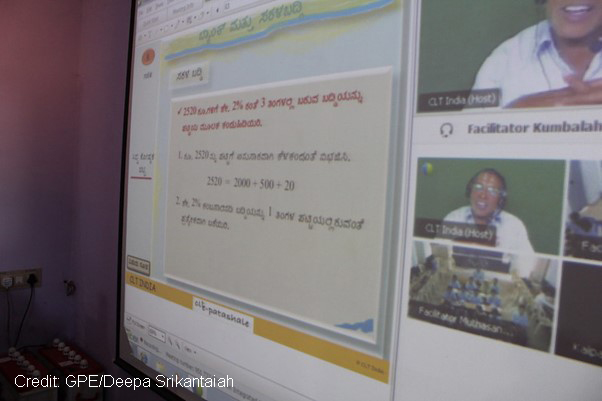This blog was written by Jyoti Seth (a primary school teacher in India).
The challenging school closures due to the COVID-19 pandemic provided parents with an insight into online education in India. While some parents preferred online classes over the traditional face-to-face medium, others were frustrated about the negative aspects of online education. With these contrasting opinions as a backdrop, this blog attempts to examine the reality of online education in India.
Learning during school closures did not come close to true online education
The global emergency due to the virus outbreak called for a complete rapid shift of teaching and learning processes. As our traditional schools moved to virtual learning overnight, this transition was mostly unplanned and prone to many problems.
With issues like student engagement, planning and execution of online classes, lack of teaching resources, and difficult access to technology, most teachers had to undergo a tough period while trying to maintain children’s education.
Especially in rural India, several teachers and students faced challenges with this sudden shift to online learning. They lacked the basic infrastructure, knowledge and accessibility to thrive in a virtual learning environment.
Because of the narrative of lack of resources in rural India, most believe that the idea of online schooling has been discarded and teachers and students are desperately waiting to get back on track with face-to-face classes. But there is another side to this story…
Despite all of the hardships and initial challenges, many Indian stakeholders have accepted this visionary medium as a credible alternative. The Times of India conducted a survey, which shows the growing acceptance of online education across various rural areas in India. Two findings include:
- 11% of rural families brought a new mobile phone during school closures.
- 2% of students in rural India received material through WhatsApp.
India Today also highlighted the enthusiasm of rural schools and colleges to adapt perfectly to ELearning. This highlights the start of a new era. India already had the second highest number of internet users by 2019. It is the second largest internet market across the world with 624 million active users by February 2021.
Further evidence in favour of the growing popularity of online education in India is the revenue of the well-known learning app ‘Byjus’. Statistics show that the revenue generated by this brand in 2019 was triple that of the previous year. It also has a large base of 2.8 million paid customers in the country.
The focus on health issues and the unplanned shift to virtual learning meant that no one could make the most of the benefits of online education. What teachers and learners experienced during the pandemic is different to the reality of a structured online school.
Advantages of online education in India
UNESCO’s Futures of Education synthesis report acknowledges the power of virtual learning to personalise instructions for different types of learners in India.
Even the Indian Government has embraced the new era of online education. The Vice President called for a digital literacy mass movement in India in 2020, showing the Government’s readiness to work towards digital literacy. With government initiatives and growing awareness amongst educators, we can expect virtual education to support physical schools in the goals of universal inclusion, addressing gender biases and improving drop-out rates.
Digital schools can be a hub for quality learning through each stage of formal education. Engaging with learning through an online platform can build the skills needed for children’s future. Some of the key benefits of structured online learning include:
- Guaranteed health safety: Traditional schools will never be free from the risk of COVID-19 unless all teachers and students are vaccinated. Vaccination would also need to occur at frequent enough intervals to cover immunity periods. Until the entire population is vaccinated, online education can provide safety from being exposed to the virus.
- The use of adaptive learning technologies: Online learning is supported by management systems which help the learner and teacher save time through activities such as taking attendance, assigning homework, keeping records and marking assignments.
- Personalised schedules for learners: Virtual schooling can offer choices to thrive through self-paced study schedules. So the struggles of learning gaps within a crowded classroom could be a concern of the past. For parents, online schooling can provide the opportunity to strengthen their child’s academic base by focusing on individual weaknesses and academic gaps.
Workable areas of online education in India
Schooling during the pandemic has taught us some invaluable lessons and has once again reiterated the importance of planning ahead for the unforeseen.
The country’s overall ‘digital literacy’ levels need to be improved in order to make the most of technology-based education. The Government of India has already started to work towards this. One initiative is the ‘PRADHAN MANTRI GRAMIN DIGITAL SAKSHARTA ABHIYAAN (PMGDISHA)’, which aims to reach out to 40% of India’s rural population and offer free digital literacy courses for citizens between the ages of 14 to 60.
Researchers have found this initiative highly effective in raising the quality and standard of education. And hopefully these efforts will help towards bridging the digital divide.
What went wrong during the pandemic?
Many believe that remote learning is not as effective as face-to-face learning. This is based on partial preparation from most traditional schools and the overnight shift to online learning. Most teachers are not trained in online teaching so their classes can seem sub-standard and ill-planned.
The reality of structured online education is still unknown to most of us. Students can engage more through home-based online schooling if teachers are experienced and knowledgeable enough to conduct effective online classes for all age groups.
Summary
The pandemic has highlighted the vital role of education and the importance of threat-free, high-quality learning. Amongst the vaccine hopes and the back-to-school endeavours, there is a lot that we are choosing to overlook.
Reopening schools has its own set of challenges. Schools now have the burden to shoulder additional responsibilities (according to COVID guidelines). For many institutions that are already struggling with financial challenges, the additional expense of sanitation, structure maintenance and basic amenities is an additional cause for concern.
Digital education is not a temporary solution but, if planned and delivered correctly, and to all students equally, has the potential to unlock a world of opportunities for learners.






Extremely interesting. Thank you for giving such an informative blog.
Thank you very much for your comment, I really appreciate it.
We all have seen the Indian education system fall when it came to traditional schooling. The difference of hierarchy caused the rural and lower class of the population to struggle in the bounds of regular schooling.
We have high hopes for digital/ online education in India. It has the potential to help us overcome the gap in our education system by providing advanced learning experience to the all the students with the help of modern day Edtech and distance education.
Thank you for giving us such a thorough article. It must have taken a lot of research for publishing this.
We all hope that this immediate shift to online education helps us overcome a lot of problems that we have faced in the past. This evolution in the way of imparting education can bring happiness to many young faces in our country.
Thank you very much for your comment, I really appreciate you taking the time to express it.
A very Insightful analysis, the real picture of the Indian education system. Our future depends on virtual developments. Thank you for sharing your research and insights.
This is a blog that one must read to know about online education in India. It is a great blog to read and understand the methods and advantages of online education for students. This also elaborates the ways in which inline education is different from the traditional ones. It is a very good read if you are looking for engaging and informative content on online education.
It is true. With everything going online, increased usage of Artificial Intelligence, and new online courses coming out every other day, the emphasis on education technology is growing dramatically!
In the future, we might have to switch to a virtual learning environment; Perhaps in 2050. But why just now? Why is it today? Why in 2022?
What would happen to entrance examinations?? What about UPSC, IIT-JEE, and other exam preparation? Even competitive exam preparations are going digital.
Online education is growing in popularity; yet, what will happen to our culture?
Please share your thoughts on the cultural aspects of online teaching and learning.